最新版本苏教版牛津译林版三年级英语on the farm)
小学英语牛津译林版三年级下册Unit 7 On the farm 第一课时 课件
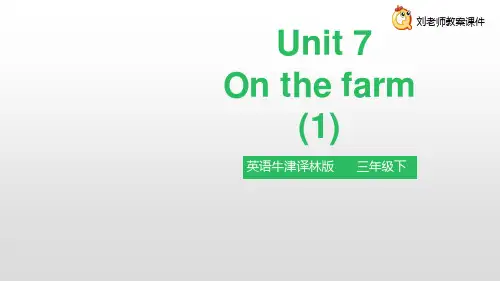
刘老师教案课件
Tips: 一般情况下,英语 单数名词变复数名 词,在后面直接 加”s”即可。
apple
A: What are these?
this 这个
s
这些是什么?
these 这些
they’re=they B: They’re
are
apples.
Let’s learn.
What are these?
aren’t
4.A: What are those? B: They are __d_u__c_k_s____.
pear s
刘老师教案课件
Let’s learn
你家有个农场,你的小伙伴来参观,你能为他 介绍你的农场吗?试着编段小对话。
A: Welcome to my farm. B: How beautiful! What are these/ those? A: They’re… B: Are these/ those…? A: Yes, they are. /No, they aren’t. They’re…
This is for you./ Here you are. B: Thank you.
刘老师教案课件
Enjoy a song
On the farm Pigs on the farm go “oink, oink”.
Pigs on the farm go “oink, oink”.
Pigs on the farm go “oink, oink, oink”.
Chant: What, what, what are these? Are, are, what are these? These, these, what are these?
2024年牛津译林版英语三年级下册教案全册
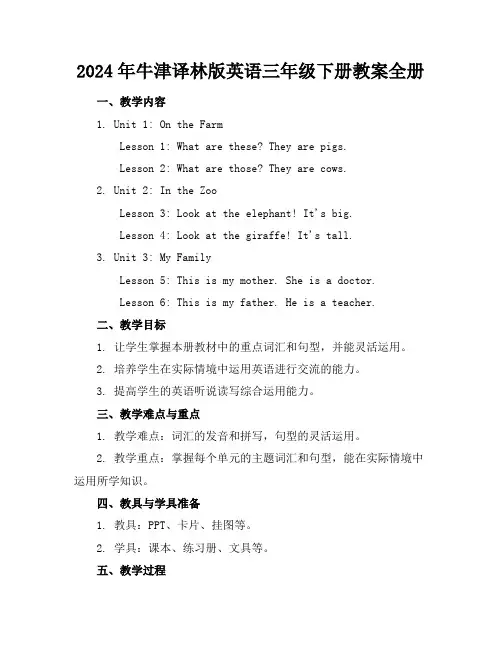
2024年牛津译林版英语三年级下册教案全册一、教学内容1. Unit 1: On the FarmLesson 1: What are these? They are pigs.Lesson 2: What are those? They are cows.2. Unit 2: In the ZooLesson 3: Look at the elephant! It's big.Lesson 4: Look at the giraffe! It's tall.3. Unit 3: My FamilyLesson 5: This is my mother. She is a doctor.Lesson 6: This is my father. He is a teacher.二、教学目标1. 让学生掌握本册教材中的重点词汇和句型,并能灵活运用。
2. 培养学生在实际情境中运用英语进行交流的能力。
3. 提高学生的英语听说读写综合运用能力。
三、教学难点与重点1. 教学难点:词汇的发音和拼写,句型的灵活运用。
2. 教学重点:掌握每个单元的主题词汇和句型,能在实际情境中运用所学知识。
四、教具与学具准备1. 教具:PPT、卡片、挂图等。
2. 学具:课本、练习册、文具等。
五、教学过程1. 导入:通过展示与单元主题相关的实物、图片或视频,引起学生的兴趣,导入新课。
举例:在Unit 1的教学中,可以展示农场的图片,引导学生说出与农场相关的动物名称。
2. 呈现:呈现教材中的重点词汇和句型,让学生跟读、模仿。
举例:在Lesson 1中,教师展示卡片,引导学生学习新词汇“pig”。
3. 实践:设置实践情景,让学生运用所学词汇和句型进行交流。
举例:在Unit 2的教学中,可以设置一个动物园的情景,让学生扮演游客,用英语描述看到的动物。
4. 例题讲解:针对每个单元的重点句型和语法,设计例题进行讲解。
举例:在Unit 3的教学中,可以设计一道关于介绍家庭成员的例题。
精品译林版三年级英语下册Unit7 On the farm 知识点
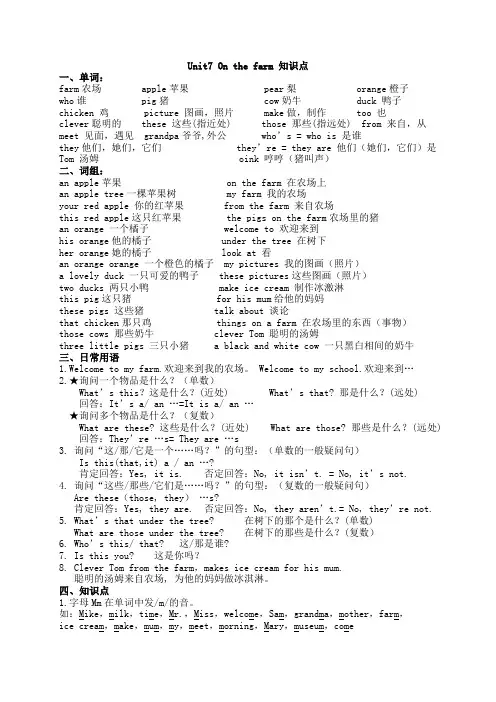
Unit7 On the farm 知识点一、单词:farm农场 apple苹果 pear梨 orange橙子who谁 pig猪 cow奶牛 duck 鸭子chicken 鸡 picture 图画,照片 make做,制作 too 也clever聪明的 these 这些(指近处) those 那些(指远处) from 来自,从meet 见面,遇见 grandpa爷爷,外公 who’s = who is 是谁they他们,她们,它们 they’re = they are 他们(她们,它们)是Tom 汤姆 oink 哼哼(猪叫声)二、词组:an apple苹果 on the farm 在农场上an apple tree一棵苹果树 my farm 我的农场your red apple 你的红苹果 from the farm 来自农场this red apple这只红苹果 the pigs on the farm农场里的猪an orange 一个橘子 welcome to 欢迎来到his orange他的橘子 under the tree 在树下her orange她的橘子 look at 看an orange orange 一个橙色的橘子 my pictures 我的图画(照片)a lovely duck 一只可爱的鸭子 these pictures这些图画(照片)two ducks 两只小鸭 make ice cream 制作冰激淋this pig这只猪 for his mum给他的妈妈these pigs 这些猪 talk about 谈论that chicken那只鸡 things on a farm 在农场里的东西(事物)those cows 那些奶牛 clever Tom 聪明的汤姆three little pigs 三只小猪 a black and white cow 一只黑白相间的奶牛三、日常用语1.Welcome to my farm.欢迎来到我的农场。
译林英语三下教案Unit 7 On the farm 第四课时
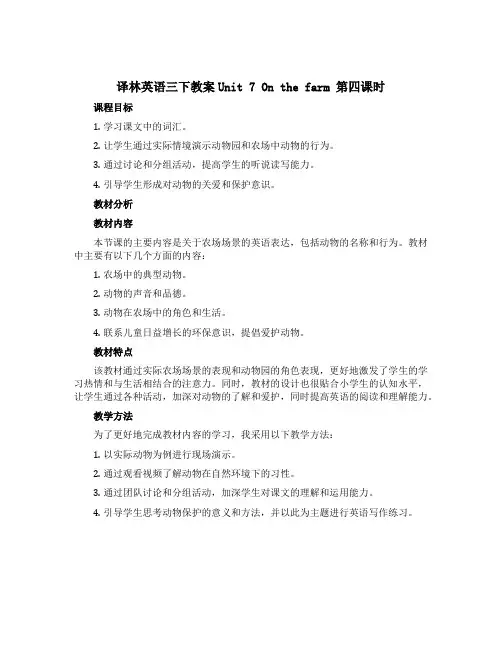
译林英语三下教案Unit 7 On the farm 第四课时课程目标1.学习课文中的词汇。
2.让学生通过实际情境演示动物园和农场中动物的行为。
3.通过讨论和分组活动,提高学生的听说读写能力。
4.引导学生形成对动物的关爱和保护意识。
教材分析教材内容本节课的主要内容是关于农场场景的英语表达,包括动物的名称和行为。
教材中主要有以下几个方面的内容:1.农场中的典型动物。
2.动物的声音和品德。
3.动物在农场中的角色和生活。
4.联系儿童日益增长的环保意识,提倡爱护动物。
教材特点该教材通过实际农场场景的表现和动物园的角色表现,更好地激发了学生的学习热情和与生活相结合的注意力。
同时,教材的设计也很贴合小学生的认知水平,让学生通过各种活动,加深对动物的了解和爱护,同时提高英语的阅读和理解能力。
教学方法为了更好地完成教材内容的学习,我采用以下教学方法:1.以实际动物为例进行现场演示。
2.通过观看视频了解动物在自然环境下的习性。
3.通过团队讨论和分组活动,加深学生对课文的理解和运用能力。
4.引导学生思考动物保护的意义和方法,并以此为主题进行英语写作练习。
教学过程Part 1 自然环境下的动物习性1.观看动物习性的视频教师准备一段与课文内容相关的视频,并放映给学生观看。
教师在放映时,要引导学生仔细观察视频中的动物行为习性,提醒学生观看时注意声音和动作等细节。
2.小组讨论分享观察结果将学生分为小组,让同一组内的学生交换意见,讨论动物的主要行为和习性,同时让学生通过讨论来丰富自己对课文内容的理解。
3.整合讨论结果让每个小组的代表向全班汇报他们的讨论结果,让学生听取不同组的意见后更好地理解课文内容。
Part 2 游戏互动环节1.角色扮演将园游会角色扮演,分为动物和游客两大组。
让学生们扮演动物,运用课文所学知识,如动物的习性、饮食、行为等,展示动物在不同时间和情况下的变化和表现。
2.游戏互动将学生分为两个组,并在戏剧性、趣味性和互动性的基础上,设计不同的游戏项目,让学生在游戏中加深对课文内容和动物保护意义的理解。
新版牛津译林苏教版三年级unit7 On the farm Story time课件
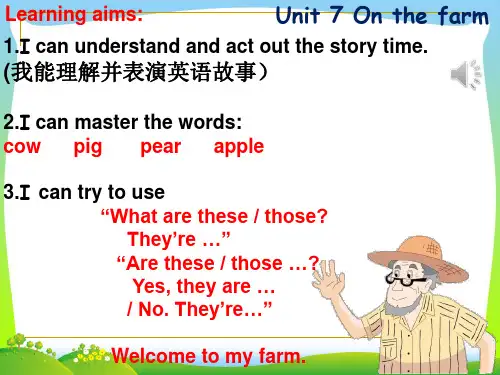
• 17、儿童是中心,教育的措施便围绕他们而组织起来。2021/8/12021/8/12021/8/12021/8/1
• 2、Our destiny offers not only the cup of despair, but the chalice of opportunity. (Richard Nixon, American President )命运给予我们的不是失望之酒,而是机会之杯。二〇二一年六月十七日2021年6月17日星期四 • 3、Patience is bitter, but its fruit is sweet. (Jean Jacques Rousseau , French thinker)忍耐是痛苦的,但它的果实是甜蜜的。10:516.17.202110:516.17.202110:5110:51:196.17.202110:516.17.2021 • 4、All that you do, do with your might; things done by halves are never done right. ----R.H. Stoddard, American poet做一切事都应尽力而为,半途而废永远不行6.17.20216.17.202110:5110:5110:51:1910:51:19 • 5、You have to believe in yourself. That's the secret of success. ----Charles Chaplin人必须相信自己,这是成功的秘诀。-Thursday, June 17, 2021June 21Thursday, June 17, 20216/17/2021
(跟读5遍)
2. Search many more words about fruit or animals.
苏教牛津译林版三年级英语下册Unit 7 On the farm同步练习
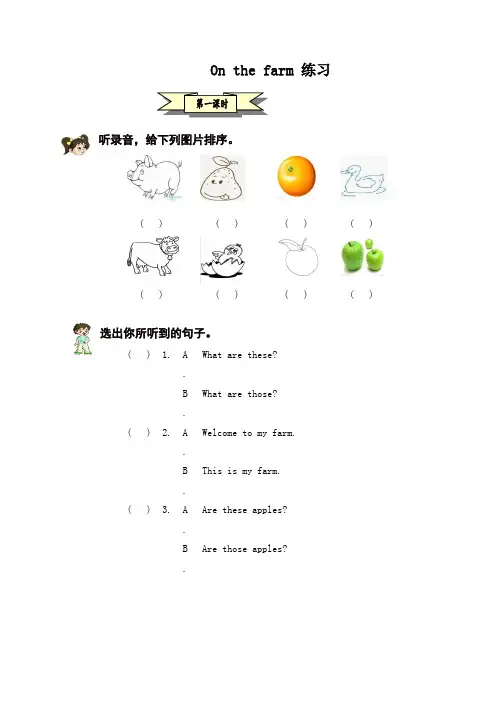
On the farm 练习听录音,给下列图片排序。
( )( )( )( )( )( )( )( )选出你所听到的句子。
( ) 1. A.What are these?B.What are those?( ) 2. A.Welcome to my farm.B.This is my farm.( ) 3. A.Are these apples?B .Are those apples? 第一课时On the farm 练习听录音,给下列句子排序。
( ) What are these?( ) What is this?( ) Who is this?( ) Is it a duc?( ) What are those?( ) They are ducs.选用“a ”或“an ”填空。
1._________ cow 2. _________ pig3._________ orange 4. _________ apple 5._________ duc 6. _________ eggOn the farm 练习听句子,填入所缺单词。
第二课时第三课时1—Welcome to my _________..—Than _________.—What are ___________?2.—They are __________.—What are ___________?3.—They are __________.—Are these __________?4.—No, they aren’t. They are __________. Array想一想,你能写出几个含有m且m发音相同的单词?On the farm 练习选择填空。
( ) 1What are _______ over there?.A. theseB. thatC. thoseThey are _________.( ) 2.A. cowsB. a cowC. cow________ a duc?( ) 3.A. It isB. Is itC. Are they( ) 4—Are they pigs? —____________..A. Yes, it is.B. Yes, they are.C. Yes, they aren’t.连词成句。
牛津译林版三年级英语下册(3B)Unit7 On the farm(第1课时) 课件
Nice to meet you.
Tip: 注意模仿人物语气,看清楚标志。
表示阅读时用升调 表示阅读时用降调 表示阅读时要连读
Let’s listen and repeat.
What are these? They’re pigs.
What are those?
They’re cows.
Let’s listen and repeat.
Let’s play and check.
AAWrereeWWtlhcthhTheoaashomttesaaeyearr’tpeeraoepttmhhlpeoelisyegss?sfeea.?t?romo.?
Let’s show.
Step 1. Read or act. (朗读或表演课文。)
Step 2. Sing the text. (演唱课文。)
Are these apples?
(这些是不是苹果呢?)
No. They’re pears.
为什么Mike还要问那些 是不是苹果呢?(可以用 中文回答)
Let’s play a guessing game.
Yes, they’re apples.
Are these apples?
(这些是不是苹果呢?)
apples
pears where
oranges
They’re … (他们是…)
chickens ducks pigs cows
Let’s listen and answer.
Liu Tao’s Grandpa
Who is he?(他是谁?) Where are they?
(他们在哪里?)
They’re on the farm.
小学英语牛津译林苏教版三年级下册()Unit7 On the farm Story time优课件
watch and choose
What do Mike and Liu Tao see on the farm? (Mike和Liu Tao在农场上看到了什么?)
A. animals(动物)B. toys C. fruit(水果)D. friends
I’m ... Welcome to my farm. Look, these are…s. Those are…s. They’re nice.
Fruit Garden (果园)
Stock farm(畜牧场):
小熊闯关游戏之农场晚会
Let’s enjoy:
Summer vacation is coming, to personally experience the farm with your parents!
Listen to a song
farm (农场) car -- far a farm
on the farm (在农场)
Unit 7 On the farm
( Story time)
Welcome to my farm.
welcome to… 欢迎来到……
Fruit Garden(果园) Stock farm(畜牧场)
__T__h__o__s__e____aarree
apples. pears.
They’re all lovely.
小熊闯关游戏之农场晚会
TTasaksk21 第二关:遇到下面情况你应该怎么说?
• 1 欢迎别人来到这里。你应该说:
Welcome to……!
• 2 询问离自己近的一些物品名称,你应该说:
苏教版牛津译林版小学英语三年级下册Unit 7 On the farmword教案
Step3 Consolidation
1.Read the dialogue after the tape
Read in role
Read in groups
Step 2 Presentation
Fun time
出示B部分图片的一部分,让学生猜测、
1.T: Let’s play a game’Look and guess’(教师出示苹果局部图) What’s this?
Guess.
S1: It’s an apple.
T: What are these? Guess!
Act out the story
2.Act Grandpa to introduce the farm
T: Now, you’re grandpa.Can you introduce your farm?
Ss: I’m Grandpa.I’m happy to see you.Welcome to my farm.Let me show you around my farm.Look, these are…. Those are…They’re…..
C. Try to sing the song
Step2 : Presentation
1.准备一些小动物头饰,再准备一幅农场的图画和歌曲《Old MacDonald had a farm》
T:(播放歌曲)Let’s listen to a song first.
Ss:(听歌曲)
T: (教师指着农场对学生说) Look, this is a farm.It’s Old MacDonald’s farm. What’s on the farm? (出示课题)教师领读on the farm.
(完整版)Onthefarm教案
On the farm 》教学案例如东实验小学沙丽蓓随着三年级新教材的运用,低年级的语篇教学受到前所未有的关注。
下面以《牛津小学英语》(译林版)3B Unit7 On the farm 的story time 教学为例,介绍笔者实施低年级阶段语篇教学的实践与反思。
一、教材简析3B Unit7 On the farm的教学内容围绕“参观农场”展开,通过Mike参观农场时,不断向刘涛及刘涛爷爷提问情景,引出一些有关农场的词汇及对近处,远处物体的提问。
从语言知识的层面讲,本单元在牛津小学英语3B整册教材中起着承上启下的作用。
从本单元起,教材开始初步涉及“名词复数”,这也是小学阶段英语重点和较难掌握语法之一。
本节课的主题是农场,学生会十分向往农场生活,对新知学习充满渴望和期待。
但由于很少有学生有去过农场的经历,教师要充分运用多种教学手段,让学生了解和关注农场,通过文本体验与拓展,初步感悟农场的乐趣。
二、教学过程(一)Pre-reading Activities1.课前分组,激发兴趣上课伊始,教师与学生互动,将学生分为两组:苹果队和梨子队。
教学分析:低年级的学生对显性的竞争非常感兴趣。
教师分组评价,引出竞争机制。
使得课堂评价更加直观、便捷、高效,有效地激发学生参与的积极性和主动性。
2.歌曲欣赏,导入话题首先播放歌曲视频Old MacDonald had a farm. 让学生欣赏歌曲并找出歌曲中出现的动物:pigs, ducks, cows. 教授单词pig, duck, cow 及复数形式。
师生边做动作边唱:Old MacDonald had a farm.教学分析:欣赏英文歌曲视频,创设了良好的英语学习氛围,有效激发学生英语学习的兴趣。
而且,歌曲内容与本节课教学内容紧密相连,视频播放营造了真实的语言环境,由歌曲引出本节课新授单词及复数形式。
在新授单词过程中,笔者应用模仿动物声音和动作,充分激发学生学习兴趣。
- 1、下载文档前请自行甄别文档内容的完整性,平台不提供额外的编辑、内容补充、找答案等附加服务。
- 2、"仅部分预览"的文档,不可在线预览部分如存在完整性等问题,可反馈申请退款(可完整预览的文档不适用该条件!)。
- 3、如文档侵犯您的权益,请联系客服反馈,我们会尽快为您处理(人工客服工作时间:9:00-18:30)。
A: What are these? B: They're s. ` A: What are those? B: They're s.
Riddle They're green. They're yellow. They're sweet. They're sour(酸的).
ch there air a pears
Question3:What’s on the farm?
(农场上有什么? )
What’s on the farm ?
What’s on the farm ?
Listen and underline
Learning tip(学习小提示) 听课文录音,找一找,Mike在农场里问的几个问题分 别是什么?请用“ ”将它们划出来。
1. What are these ? 3. Are these apples ?
2. What are those ?
4. Are those apples , too ?
Read and match
Learning tip(学习小提示)
Grandpa和Liu Tao是怎样回答Mike的四个问题的呢?
Hello/Good afternoon, I’m … Nice to meet you!
Welcome to my class.
欢迎来到我的课堂。 Thank you.
big a pigs They’re 它们是…
(复数) s. 猪
these 这些
those 那些
how now a cows
Homework
1.Copy the new words. (抄写新单词。) 2.Read Story time after the tape. (跟录音朗读课文。) 3. Introduce the farm to your parents. (向父母介绍农场。)
(这是谁的农场?)
Question3:What’s on the farm?
(农场上有什么?)
Watch and answer
Question2:Whose farm is this? (这是谁的农场?)
试着读出友好 欢迎的语气哦!
Welcome to my farm.
Watch and circle
大声朗读课文,根据所给图片选择合适的答句。
A: They’re cows . C: No. They’re pears .
B: They’re pigs . D: Yes. They’re apples .
Make a dialogue
Tips: 四人一组 ,其中一人为农场 主人。 (复数)
Question1:Where are they?
( 他们在哪里?)
Question1:Where are they? ( 他们在哪里?)
A.On the farm B.In the park
在公园 在农场
Watch and answer
Question2:Whose farm is this?
A: Welcome to my farm. Nice to meet you. B/C/D: Nice to meet you, too. B: What are these/those? A: They’re … C: Are these…? A: Yes/No,they’re… D: Are those…? A: Yes/No,they’re…
